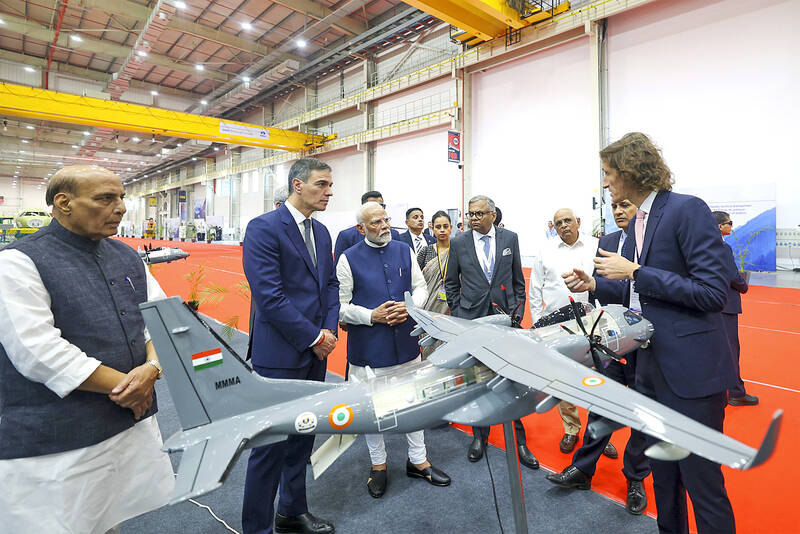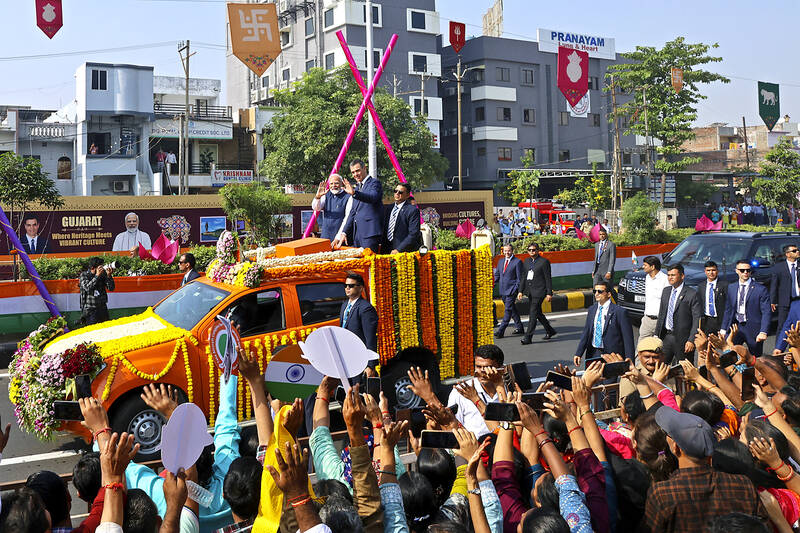Indian Prime Minister Narendra Modi and his Spanish counterpart, Pedro Sanchez, yesterday inaugurated India’s first private military aircraft plant, boosting New Delhi’s ambitions of growing local manufacturing in its defense and aerospace industries.
Sanchez was welcomed to the country with a roadshow in Gujarat state’s Vadodara city where hundreds of people cheered and waved banners.
The two leaders then launched the Tata Aircraft Complex, the manufacturing hub that will produce the Airbus C-295 transport military aircraft in collaboration with Airbus Spain and to be deployed by the Indian air force.

Photo: AP
Sanchez said the project was a triumph of Modi’s vision “to turn India into an industrial powerhouse and a magnet for investment and business-to-business collaboration.”
“This partnership between Airbus and Tata will contribute to the progress of the Indian aerospace industry and will open new doors for the arrival of other European companies,” he added.
“This new aircraft factory will boost new skills and new industries in India,” Modi said, adding that the country was now supplying parts to the world’s leading aircraft companies.

Photo: AP
Tata conglomerate chairman Natarajan Chandrasekaran hailed it as a historic day for the country’s defense sector and credited the late Ratan Tata, the industrialist and former chairman who died earlier this month, for conceiving the idea more than a decade ago.
Under a US$2.5 billion deal signed in 2021, Airbus is to deliver the first 16 of the aircraft from its final assembly line in Seville, Spain — six of them have been delivered to the Indian air force so far. Tata Advanced Systems Ltd is to produce 40 of the aircraft in the Vadodara plant, which is expected to roll out the first C-295 aircraft made in India in 2026. The aircraft can transport up to 71 troops or 50 paratroopers and will be able to access remote locations. It can also be used for medical evacuations and aid in disaster response and maritime patrol duties.
Since coming to power in 2014, Modi has vowed to turn India into a global manufacturing hub, including in infrastructure, pharmaceuticals and defense. As part of an effort to modernize and reform military equipment, the government has sought to grow the private defense manufacturing sector, a space previously occupied solely by the government-run organizations, and has eased foreign direct investment regulations to try and encourage companies to establish themselves in India.
The visit marks the first by a Spanish leader to India in 18 years. During the two-day visit, Sanchez is to hold talks with Modi to review ties between the countries and also speak with Indian Minister of Foreign Affairs Subrahmanyam Jaishankar.
Sanchez is to travel today to Mumbai, India’s financial capital and home to Bollywood, where he is expected to interact with trade and industry leaders, as well as visit film studios in an effort to grow collaboration between the Indian and Spanish entertainment industry.
Their bilateral trade stood at nearly US$10 billion last year.
According to the Indian foreign ministry, more than 200 Spanish companies actively operate in India and about 80 Indian companies in Spain.
The two leaders are expected to sign agreements that will further boost ties and cooperation in areas such as trade, information technology, renewable energy and defense, an Indian government statement said.

‘UNUSUAL EVENT’: The Australian defense minister said that the Chinese navy task group was entitled to be where it was, but Australia would be watching it closely The Australian and New Zealand militaries were monitoring three Chinese warships moving unusually far south along Australia’s east coast on an unknown mission, officials said yesterday. The Australian government a week ago said that the warships had traveled through Southeast Asia and the Coral Sea, and were approaching northeast Australia. Australian Minister for Defence Richard Marles yesterday said that the Chinese ships — the Hengyang naval frigate, the Zunyi cruiser and the Weishanhu replenishment vessel — were “off the east coast of Australia.” Defense officials did not respond to a request for comment on a Financial Times report that the task group from

Chinese authorities said they began live-fire exercises in the Gulf of Tonkin on Monday, only days after Vietnam announced a new line marking what it considers its territory in the body of water between the nations. The Chinese Maritime Safety Administration said the exercises would be focused on the Beibu Gulf area, closer to the Chinese side of the Gulf of Tonkin, and would run until tomorrow evening. It gave no further details, but the drills follow an announcement last week by Vietnam establishing a baseline used to calculate the width of its territorial waters in the Gulf of Tonkin. State-run Vietnam News

DEFENSE UPHEAVAL: Trump was also to remove the first woman to lead a military service, as well as the judge advocates general for the army, navy and air force US President Donald Trump on Friday fired the chairman of the Joint Chiefs of Staff, Air Force General C.Q. Brown, and pushed out five other admirals and generals in an unprecedented shake-up of US military leadership. Trump wrote in a post on Truth Social that he would nominate former lieutenant general Dan “Razin” Caine to succeed Brown, breaking with tradition by pulling someone out of retirement for the first time to become the top military officer. The president would also replace the head of the US Navy, a position held by Admiral Lisa Franchetti, the first woman to lead a military service,

Four decades after they were forced apart, US-raised Adamary Garcia and her birth mother on Saturday fell into each other’s arms at the airport in Santiago, Chile. Without speaking, they embraced tearfully: A rare reunification for one the thousands of Chileans taken from their mothers as babies and given up for adoption abroad. “The worst is over,” Edita Bizama, 64, said as she beheld her daughter for the first time since her birth 41 years ago. Garcia had flown to Santiago with four other women born in Chile and adopted in the US. Reports have estimated there were 20,000 such cases from 1950 to